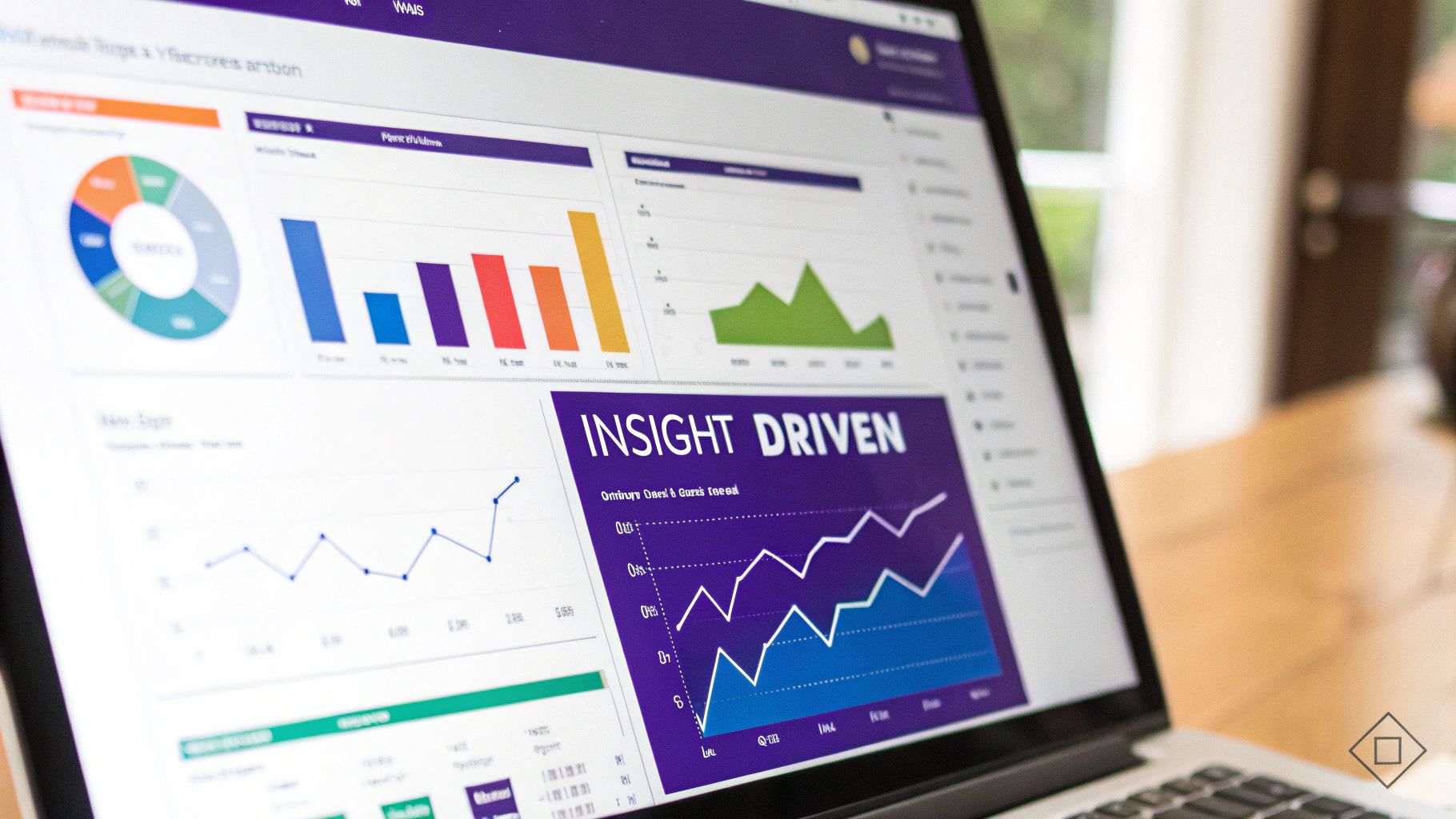Boost Business with Marketing Automation Integration
Accelerate growth with our marketing automation integration that streamlines workflows and delivers measurable ROI.
Posted by
Why Marketing Automation Integration Is Your Missing Link

Let's be honest, managing multiple marketing platforms can feel overwhelming. Each tool often operates independently, requiring separate logins, different data formats, and a lot of manual effort to keep everything synchronized. This disjointed approach isn't just inconvenient; it's holding back your marketing effectiveness. Marketing automation integration offers a powerful solution by connecting these separate tools, platforms, and databases.
This creates streamlined workflows that drastically improve efficiency.
For example, imagine a lead registers for your webinar through a form on your website. With marketing automation integration, that data instantly flows to your CRM software, triggers a welcome email sequence, adds them to a targeted social media campaign, and notifies your sales team. This interconnected system eliminates manual data entry, reduces errors, and ensures a consistent customer experience.
This is what truly effective marketing looks like.
The move towards integrated systems is rapidly gaining traction. Over 51% of companies currently use marketing automation tools. The global market, valued at $5.86 billion in 2023, is expected to reach $8.42 billion by 2027. This growth reflects a growing understanding of the benefits of streamlined processes and improved customer engagement. Find more detailed statistics here.
Bridging the Gap Between Standalone Tools and Integrated Systems
Many businesses still rely on standalone marketing tools, holding on to the perceived simplicity of individual solutions. However, this often leads to data silos, fragmented customer journeys, and wasted marketing budget. True marketing automation integration goes beyond simply automating individual tasks. It’s about building a unified ecosystem where your tools work together seamlessly.
Think of it like an orchestra. Individual instruments can create beautiful sounds on their own, but it’s the conductor, through careful coordination and integration, that brings together a truly harmonious and impactful symphony. Similarly, marketing automation integration orchestrates your individual tools to produce a more effective and cohesive marketing performance.
This integration provides your marketing team with a consolidated view of customer interactions across all channels. This empowers them to deliver personalized messages, track campaign performance more accurately, and make data-driven decisions with confidence. The difference between basic automation and strategic integration is the difference between playing individual notes and conducting a symphony. The result? A richer, more powerful, and ultimately more successful marketing performance.
The Business-Changing Benefits You're Missing Out On

Effective marketing depends on understanding your customers and delivering the right message at the right time. Marketing automation integration empowers you to achieve this. Leading companies are breaking down data silos that hinder customer experiences and using integration to create truly personalized journeys.
Reclaiming Time and Personalizing the Customer Journey
Imagine your marketing team spending hours each week manually transferring lead information between systems, updating spreadsheets, and scheduling social media posts. It's a tedious and time-consuming process. Marketing automation integration eliminates these repetitive tasks.
This frees up valuable time for strategic initiatives like developing creative campaigns and analyzing customer behavior. Furthermore, integration allows for more personalized customer journeys. By connecting your CRM, email platform, and other marketing tools, you can deliver targeted messages based on individual customer preferences and interactions.
This shift from manual processes to automated workflows significantly impacts efficiency and customer satisfaction. Instead of generic email blasts, customers receive communications relevant to their specific needs and their stage in the buying cycle. This personalized approach fosters stronger customer relationships and drives conversions.
Transforming Lead Scoring and Cross-Channel Messaging
Marketing automation integration transforms lead scoring from guesswork into a data-driven process. By integrating data from various sources, such as website activity, email engagement, and social media interactions, you can assign accurate lead scores.
This helps prioritize high-potential leads and focus sales efforts where they are most likely to succeed. Sales teams receive qualified leads, and marketing efforts are more effectively targeted. The integration of marketing automation has a profound impact on return on investment (ROI). Studies show that for every dollar spent, companies see a return of $5.44 over three years, with 44% seeing ROI within six months. B2B marketers using these techniques experience an average 20% increase in sales opportunities. Explore this topic further.
Moreover, integrated systems enable consistent cross-channel messaging. Instead of disjointed messages across different platforms, customers receive a unified brand experience. Whether they interact through email, social media, or your website, the messaging remains consistent. This cohesive approach builds trust and strengthens customer loyalty. You might be interested in: How to master marketing automation for small businesses.
Achieving True Sales and Marketing Alignment
Finally, proper marketing automation integration fosters sales and marketing alignment. When both teams have access to the same data and insights, they can work together more effectively.
This shared understanding of the customer journey leads to better lead qualification, improved communication, and ultimately, increased revenue. By breaking down the traditional silos between sales and marketing, businesses create a powerful synergy. This collaboration ensures that everyone is working towards the same goals.
To illustrate the potential ROI impact, let's examine some key metrics:
The following table shows a comparison of key performance indicators before and after marketing automation integration implementation.
| Metric | Before Integration | After Integration | Average Improvement |
|---|---|---|---|
| Leads Generated | 100 | 250 | 150% |
| Conversion Rate | 2% | 5% | 150% |
| Sales Revenue | $10,000 | $25,000 | 150% |
| Customer Lifetime Value | $500 | $750 | 50% |
As you can see, integrating marketing automation can lead to significant improvements across various key metrics. These improvements contribute to a stronger bottom line and a more efficient and effective marketing and sales process.
Essential Integration Points That Drive Real Results

Which connections in your technology ecosystem truly matter? This section explores the crucial integration points successful businesses prioritize when building their marketing automation foundation. We'll delve into how connecting your core systems creates the seamless customer journeys today's consumers expect.
CRM: The Backbone of Personalized Interactions
CRM integration is more than just a technical checkbox; it's the bedrock of personalized marketing. Your CRM system houses valuable customer data. Connecting it to your marketing automation platform unlocks targeted communications and individualized experiences.
For example, imagine a customer completes a purchase. This information automatically syncs with your CRM, triggering a personalized thank-you email, adding them to a loyalty program, and tailoring all future communications. This precise personalization boosts customer satisfaction and encourages repeat business.
A strong CRM integration empowers all customer-facing teams – from sales to support – with the same up-to-the-minute information. This unified perspective creates a consistent and personalized customer experience across every touchpoint.
Connecting Email, Social Media, and Content
Top-performing companies integrate their email marketing platforms, social media management tools, and content management systems. This ensures a unified message across all channels.
Picture this: you publish a new blog post. Your marketing automation system automatically shares it on social media, features it in your upcoming newsletter, and targets it to specific customer segments. This coordinated approach maximizes reach and engagement.
Furthermore, integrating your social media empowers you to track interactions and enrich your customer profiles. This provides a deeper understanding of behavior and preferences.
Analytics and E-Commerce: Data-Driven Decisions
Integrating your analytics platforms with your marketing automation system provides actionable insights. This data informs future campaigns and refines your marketing strategy.
For instance, monitoring website activity and email opens reveals what content resonates with your audience. This data-driven knowledge allows you to craft more effective messaging and target your campaigns precisely.
Moreover, e-commerce integration delivers crucial data on purchasing habits. Connecting your online store unlocks valuable insights into product popularity, purchase frequency, and customer lifetime value. This data can personalize offers and promotions, increasing sales and loyalty.
To help visualize the key differences between these integration points, we've compiled the following comparison table. This table details the implementation complexity, business impact, and recommended use cases for each connection.
Marketing Automation Integration Points Comparison
| Integration Point | Implementation Complexity | Business Impact | Recommended For |
|---|---|---|---|
| CRM | Medium | High | Businesses focused on personalized marketing and customer retention |
| Email Marketing | Low | Medium | Companies prioritizing consistent messaging across channels |
| Social Media | Low | Medium | Organizations looking to leverage social insights and expand reach |
| Analytics Platforms | Medium | High | Data-driven businesses aiming to optimize campaigns and improve ROI |
| E-commerce Platform | Medium | High | Online retailers seeking to personalize offers and increase sales |
As you can see, while CRM and Analytics integration may be slightly more complex to implement, they offer significant business impact. Email and social media integration, while simpler to set up, are still valuable tools for driving engagement and reach. E-commerce integration is particularly crucial for online retailers.
Prioritizing Integrations for Maximum Impact
Not every integration yields the same results. Some deliver immediate gains, while others contribute to long-term growth. Understanding this distinction is critical for mapping out your integration roadmap. Learn more in our article about how to master marketing automation workflows.
For instance, integrating your CRM and email marketing platform often provides immediate benefits through personalized communication and streamlined workflows. Integrating your analytics platform, while requiring more initial setup, offers substantial long-term strategic value through data-driven insights.
By focusing on integrations aligned with your specific business objectives, you maximize your return on investment and drive meaningful improvements in your marketing performance. Strategically sequencing your integration plan is essential to unlocking the full potential of marketing automation. This involves carefully assessing your existing technology stack, identifying your key priorities, and implementing integrations in a phased and strategic approach.
Overcoming the Integration Hurdles Nobody Talks About

Marketing automation integration promises a seamless connection between systems and effortless workflows. But the reality often involves unforeseen complexities. Let's explore the practical challenges businesses face when implementing these integrations, and how to overcome them.
Data Quality: The Silent Saboteur
Imagine building a house on a shaky foundation. That's what it's like trying to integrate systems with poor data quality. Inconsistent formatting, duplicate entries, and missing information can lead to significant issues. Think inaccurate reporting, ineffective targeting, and ultimately, wasted marketing spend.
For businesses connecting marketing automation with other systems, exploring available integrations is key. This ensures compatibility and helps maximize automation benefits. Establishing a clear data governance process is also essential. This involves defining data standards, implementing validation rules, and regular database cleaning. These proactive steps ensure your integrated systems operate smoothly.
System Compatibility: Beyond the Sales Pitch
While vendors often tout seamless integrations, the truth can be far more nuanced. Unexpected compatibility issues can arise. Different systems may use different data formats or APIs, requiring custom coding or workarounds. This adds complexity and cost to the project.
Before investing in new marketing automation tools, thoroughly assess their compatibility with your existing systems. Conduct pilot tests and involve your IT team early in the process. This proactive approach avoids costly surprises and ensures a much smoother integration.
Organizational Resistance: Winning Over Your Team
Introducing new systems often encounters internal resistance. Team members comfortable with existing workflows may hesitate to adopt new processes. This resistance can stall integration projects and limit their overall effectiveness.
Effective change management is crucial. Communicate clearly with your team, outlining the integration's benefits and addressing any concerns. Provide adequate training and support for a smooth transition. This collaborative approach fosters buy-in and increases the chances of successful implementation.
Building a Sustainable Integration Strategy
Overcoming these integration hurdles requires a strategic and proactive approach. A thorough audit of your current data is a good starting point. Assess your system compatibility and foster open communication within your organization. This creates a solid foundation. For insights into building trust and credibility, a key element of successful integration, check out this guide on How to Master Testimonial Marketing Strategies.
By addressing data quality, system compatibility, and organizational resistance head-on, you can transform marketing automation integration. Instead of a potential headache, it becomes a powerful engine for growth. This thoughtful approach ensures your integrated systems deliver increased efficiency, improved customer experiences, and better business outcomes. The result? A truly integrated and effective marketing ecosystem.
Building Your Marketing Automation Integration Roadmap
Turning your vision of a smoothly integrated marketing automation system into reality needs a well-defined roadmap. This plan should align with your business objectives and lay out achievable steps to get there. This means understanding your current marketing tech stack, pinpointing key integration priorities, and planning for a seamless implementation.
Assessing Your Current Marketing Technology Ecosystem
Before diving into integrations, take a look at the tools you're currently using. Which systems are in place? How do they interact (or not interact)? It's important to identify existing connections, overlapping data, and potential conflicts. This initial assessment helps you understand your starting point and prioritize integrations for maximum impact.
For example, if you're already using a CRM, evaluate its functionality and data quality. Is the data clean and current? This information will guide how you integrate it with other platforms. This upfront evaluation sets the stage for a more efficient and effective integration process.
Identifying Integration Priorities and Sequencing Projects
Not all integrations are equal. Connecting your CRM and email platform, for instance, can quickly boost communication and efficiency. Integrating analytics platforms, on the other hand, may require more initial effort but offers valuable long-term strategic benefits.
Successful companies prioritize integration projects based on: business value, resource requirements, and implementation complexity. Focusing first on high-value, manageable integrations allows you to demonstrate quick wins and gain momentum.
Evaluating Technology Partners and Building Your Team
The right technology partners are essential for integration success. Don't just focus on feature lists. Consider the vendor's reputation, support services, and their ability to integrate with your existing systems.
Also, assemble a cross-functional team with members from marketing, sales, IT, and other relevant departments. This collaborative approach ensures the integration meets everyone's needs and promotes company-wide adoption.
Establishing Realistic Timelines and Governance
Setting realistic timelines is crucial. Integration projects often take longer than expected due to unforeseen technical issues or internal roadblocks. Building in buffer time allows for flexibility.
Finally, establish clear governance systems. These guidelines define how data is managed, systems are maintained, and integrations are updated. This ensures long-term integrity, even as teams and technologies evolve. This proactive approach prevents future problems and keeps your integrated systems effective and adaptable.
Future-Proofing Your Marketing Automation Integration
Building a successful marketing automation integration isn't a set-it-and-forget-it task. It's an ongoing process of adapting to the ever-changing world of technology. This section explores emerging trends shaping the future of integrated systems and provides insights to help you prepare.
The Rise of AI-Powered Automation
Artificial intelligence (AI) is transforming marketing automation from basic, rule-based systems into intelligent solutions. AI brings predictive analytics and automated optimization to the forefront, enabling systems to learn and adapt to customer behavior.
For instance, AI can analyze past customer interactions to predict future purchases. This allows for proactive product recommendations and personalized offers. AI-powered systems can also automatically adjust campaign parameters, like bid amounts and targeting criteria, to maximize effectiveness and ROI. This shift to intelligent automation empowers marketers to anticipate customer needs and optimize campaigns in real-time, ultimately leading to improved customer experiences and increased conversions.
Navigating the Changing Landscape of Data Privacy
With growing emphasis on data privacy, businesses must re-evaluate their first-party data integration strategies. Regulations like GDPR and CCPA are changing how companies collect, store, and use customer data.
This means marketers need to prioritize transparency and consent in their data collection practices. They also need to find ways to integrate data securely and responsibly while respecting customer preferences. These changes, however, don't signify the end of personalized marketing. Companies prioritizing ethical data integration can still deliver relevant experiences while complying with regulations. This approach builds customer trust, a vital component of long-term success.
The Democratization of Automation Through No-Code Platforms
No-code integration platforms are empowering businesses without extensive technical expertise to access sophisticated automation capabilities. These platforms enable marketing teams to connect systems and build automated workflows without relying on developers.
This increased accessibility breaks down a significant barrier to entry for smaller businesses or those with limited IT budgets. It also allows internal technical teams to focus on more complex projects. This democratization of automation unlocks a wealth of possibilities for businesses of all sizes to harness the power of integrated marketing.
The Expanding World of Voice and IoT
Voice assistants and IoT (Internet of Things) devices are creating new frontiers for marketing automation integration. These connected devices generate invaluable data on customer behavior and preferences.
Imagine a scenario where a customer's smart thermostat notifies your marketing automation platform that they are running low on heating oil. This could automatically trigger a timely email offering a discounted refill. This level of personalized and contextually relevant messaging presents exciting new opportunities for customer engagement. These emerging integration points are still evolving, but understanding their potential now will provide a significant advantage in the future. Preparing your team and technology stack for these innovations will allow you to stay ahead of the curve and craft truly personalized and impactful customer experiences. Are you ready to elevate your marketing automation? EndorseFlow offers a comprehensive platform to streamline your testimonial collection and social media management, integrating seamlessly with your existing tools. Start your free 14-day trial today and discover how EndorseFlow can transform your marketing efforts. Discover the power of EndorseFlow.